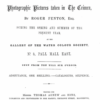
Peter H. Hoffenberg, “The Official Opening of ‘The Exhibition of the Photographic Pictures taken in The Crimea by Roger Fenton, Esq.'”
The first public exhibition of war photographs opened in London in late September 1855, during the costly and controversial Crimean War. The show introduced over 300 black and white images taken by well-known photographer Roger Fenton (1819-1869) and continued with various additions over the next several months in Britain. Later host cities included Manchester, Birmingham, and Belfast. Queen Victoria and Prince Albert were the leading sponsors of the shows. The first exhibition was well chronicled at the time, and this essay reviews some of those public contemporary responses, published primarily in major newspapers and periodicals, as well as in photographic society journals. Those responses are considered in light of the history of photography, mid-Victorian matters of art, science and war, and common conclusions at the time and that the show was primarily a work of propaganda to support the Crimean War and that Fenton’s images were not realistic.
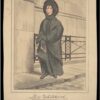
Rebecca Nesvet, “Miss Whitehead, ‘The Bank Nun’”
An urban legend maintains that early in the nineteenth century, one Miss Whitehead, colloquially known as “the Bank Nun,” frequently visited the Bank of England to accuse that institution of destroying her brother, a financial forger. This essay traces the evolution of this legend. I contend that in 1837, an obscure comic sketch reacted to that year’s major financial crisis by dredging up the Romantic-era case of financial forger Paul Whitehead and focusing on his surviving sister. Displacing her brother’s notoriety onto her, the sketch reinvents her as “the Bank Nun,” a grotesque magnet for lingering Romantic-era anxieties about the circulation of paper credit, financial forgery, and women. A succession of plagiarisms, retellings, and reappraisals of this ephemeral sketch and its portrait illustration made the Bank Nun a folk heroine of enduring resonance. Via this iconic figure, Romantic-era economic controversy haunts London today.
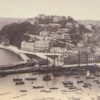
Troy J. Bassett, “‘More than a Bookseller’: Iredale’s Library as the Center of Provincial Literary Life”
Andrew Iredale welcomed Her Royal Highness Princess Victoria and her cousins to his library in Toquay, Devon on 1 September 1898 where the group bought books and photographs. Founded by Iredale in 1872, Iredale’s Library became the “centre of literary life” in the seaside resort community well into the twentieth century. This article considers the circulating library’s role in the community: in addition to selling and lending books, the library served as a place for public and private meetings, third-party business transactions, and interpersonal networking. As the history of Iredale’s Library illustrates, provincial circulating libraries played a vital role in communities well beyond their money-making operations.
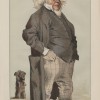
Peter H. Hoffenberg, “1871-1874: The South Kensington International Exhibitions”
The series of annual international exhibitions held during the early 1870s at South Kensington, London, were not particularly successful, or popular, but they were influential in the history of exhibitions. The alleged failures and the cancellation of the final annual exhibition halfway through the intended decade-long series of events provoked considerable discussion about the purpose, scale and expectations for exhibitions, which were no longer novel or limited to a particular city or nation-state. There were some successes, notably for the Australian colonies and British India, and for very specific trades and exhibitors, but the public discussion and those limited successes have generally failed to capture the attention of scholars. These events are rarely mentioned in books and articles about exhibitions and, when discussed, are considered to be failures without merit. This BRANCH contribution recognizes that other exhibitions were more popular and more successful, but also recognizes that the South Kensington shows were significant in addressing criticisms of exhibitions in general and in the generational history of both the shows and their organizers. The 1870s proved to be a pivotal period in the history of such exhibitions and the consideration of what merited public culture. The mantle was passed from Sir Henry Cole to his successors and the ambition of holding annual international exhibitions was replaced by more thematic shows in Britain and bold international shows in the Australian colonies. Amidst the general impressions of failure, there were also successes at the shows and those highlighted how inter-national exhibitions could prove useful in a changing world.
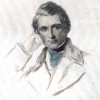
Amy Woodson-Boulton, “The City Art Museum Movement and the Social Role of Art”
British art museums developed along substantially different lines than those in Continental Europe. Rather than create a centrally supported or designed system of cultural provision, the British Parliament passed permissive legislation in the middle of the nineteenth century that allowed localities to choose to establish public libraries and museums. Cities thus founded art museums independently, at the instigation of committed local reformers and benefactors, while most national institutions proceeded by Parliamentary acts rather than through the nationalization of royal collections. A generation later, inspired by the works of John Ruskin and the new aesthetic of Pre-Raphaelitism, many men (and some women) pushed their cities to create art museums not primarily as a means to educate the public about art history, but to counteract the toxic effects of the moral and physical ugliness of industrial capitalism, and of industrial cities in particular. The resulting institutions formed a new kind of domesticated public space, bringing together ideas about the middle-class home as a refuge and about beauty as a means of “improving” the working classes. However, John Ruskin himself often criticized these efforts as too accommodating of industrial society.
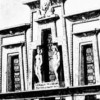
Robert David Aguirre, “Mexico, Independence, and Trans-Atlantic Exchange, 1822-24”
This entry connects the Spanish American independence movements of the 1820s to the emergence of new pathways of trans-Atlantic cultural exchange. It shows that Britain’s political recognition of the new republics opened a two-way channel in which things, commodities, persons, and ideas flowed back and forth, affecting culture and politics on both sides of the Atlantic. Focusing particularly on Britain’s relations with Mexico, this entry examines key moments in the immediate British response to Spanish American independence.
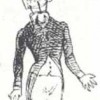
Jo Briggs, “1848 and 1851: A Reconsideration of the Historical Narrative”
The revolutionary year of 1848 has been seen as producing little effect on art in Britain. However, the turn to visual culture, which considers a broad spectrum of material including prints, illustrated periodicals, advertisements and other popular and ephemeral forms of visual production, allows this assumption to be rethought. By decentralizing the notion of an originary moment of formal innovation among a select group of avant-garde painters, as has been emphasized with regard to Paris, and turning to British visual culture, the effects of revolution become diffuse and plural. As a result, chronologies need to be rethought, and the revolutions of 1848 and the Great Exhibition of the Work of Industry of All Nations of 1851 reconnected.
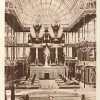
Anne Helmreich, “On the Opening of the Crystal Palace at Sydenham, 1854”
The Crystal Palace at Sydenham represents a number of key paradigms in Victorian culture: the emphasis upon visuality as a means of acquiring and conveying knowledge, the use of display as a vehicle of both education and entertainment, the desire to construct unifying historical narratives, and the emphasis upon rational recreation.
